The town of Baolai (寶來) is located along the Southern Cross-Island Highway in the upper reaches of Kaohsiung City. After suffering a devastating setback at the hands of Typhoon Morakot, the town’s tourism industry is finally showing signs of recovery. While the town itself has many commercial hot spring offerings for tourists, the adjacent Baolai River also has at least five different wild hot springs available to those with a more adventurous spirit.
SHIDONG AND WUKENG
Just before entering the town of Baolai, make two right turns to reach the bridge across the Baolai River. Immediately after crossing this bridge, there is a temple on the left. Descend to the riverbed from here, and begin walking upstream. After about an hour and a half, and a dozen crossings of the river, you will arrive at Shidong (石洞, “Stone Cave”) Hot Spring.
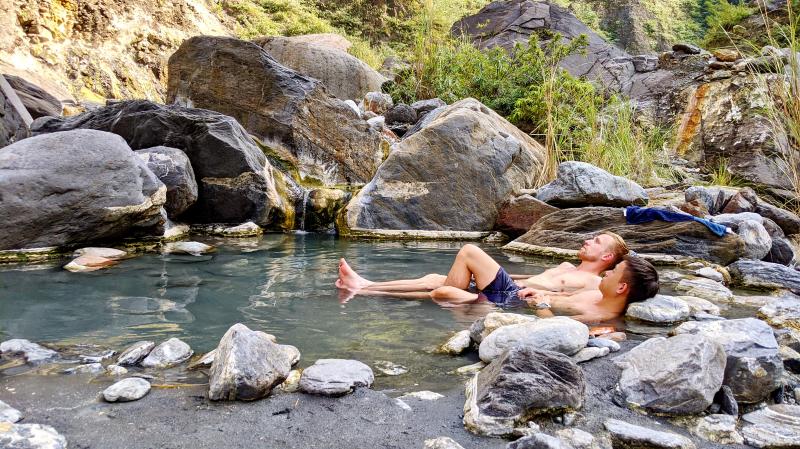
Photo courtesy of Ben Homnick
This spring’s source is a pool of hot water that is bubbling up inside an actual small cave, easily located by following the hose from the hot pool. Yes, the soaking pool here is artificial, in that the water flows in through a hose, and that the pool has been strengthened with concrete between the natural river stones. However, without these improvements it would be difficult to soak here, and the concrete and natural stone pool is a lot less visually jarring than the blue and white tarpaulins found at many other wild hot springs. As this spring is so close to civilization, it can be busy, especially on weekends. For instance, last Sunday afternoon, there were approximately 20 people here having a BBQ, soaking in the springs and singing karaoke.
Twenty minutes farther upstream is Wukeng (五坑) Hot Spring. At the time of writing, the pools here were quite small and only suitable for a foot soaking. However, the adjacent sandy beach would make for a wonderful campsite, and with a little digging, the pools could be expanded to accommodate a full-body soaking.
ROAD ACCESS: CIKENG AND SHIKENG
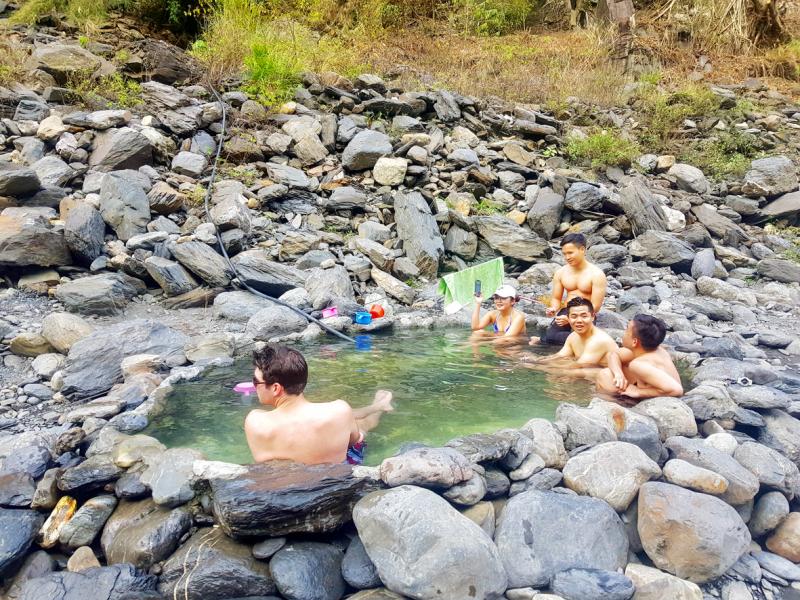
Photo: Tyler Cottenie
By turning right just before the Baolai 7-Eleven and continuing straight up the mountain, visitors will soon find themselves on the Siaoguanshan Forest Road (小關山林道). After about 15 minutes, there will be a fork in the road marked Cikeng (七坑) in Chinese. Another 30 minutes of driving on this road takes visitors down to the riverbed across from Cikeng Hot Spring. This road is quite rough in parts and only suitable for high-clearance vehicles or scooters, though the last section is all freshly laid concrete, so new it doesn’t even appear in Google Maps yet. Access to Cikeng used to require a one-hour walk down to and along the riverbed, but with this new road, there is now drive-up access.
There is one hot pool on the near side of the river with a tarpaulin bottom and shade nets above it. The actual source of the hot spring is across the river, where most of the soaking pools are also found. The pools here are clean and deep enough for full-body soaking, but the tarpaulin linings do take away from the natural atmosphere. As this hot spring is so easily accessible, weekends are guaranteed to be busy with overnight campers. However, for those who cannot, or do not wish to, walk long distances on a riverbed, Cikeng is an ideal wild hot spring destination.
Visitors who are willing to walk will not be disappointed if they undertake the three-hour walk upstream from Cikeng to Shikeng (十坑) Hot Spring. Nestled against the mountainside, Shikeng presents visitors with a beautiful green wall from which natural hot spring water emerges, running down into an eight-meter-long pool. The walls of the pool are sturdily built, allowing visitors to sit around the hot spring between soaks while still keeping warm. This is the perfect place for a long, leisurely soak under the stars with friends or family. There is a massive flat space adjacent to the spring, so camping here for the night is not a problem, either.
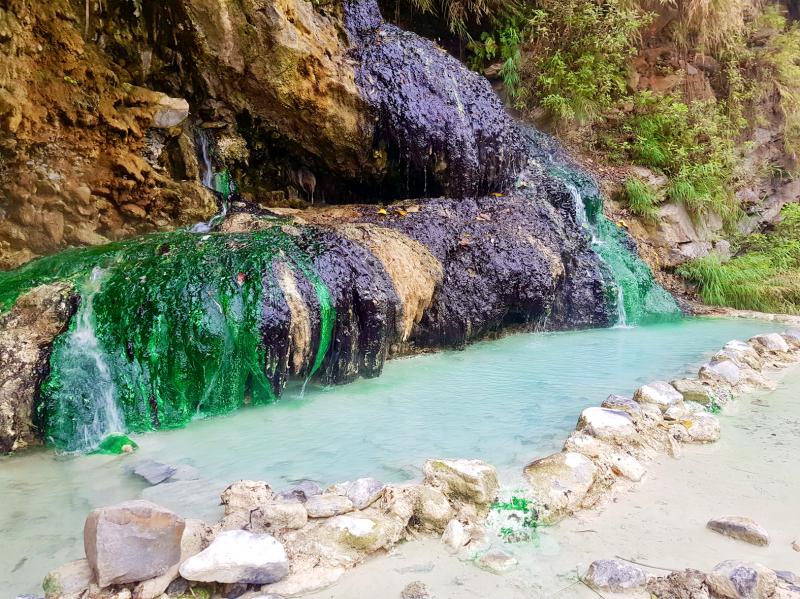
Photo: Tyler Cottenie
HIKING ACCESS ONLY: SHISANKENG
There is one big caveat that goes along with all of the aforementioned hot springs: They are all accessible to specially modified four-wheel-drive vehicles that can be driven along the riverbed. Any of these hot springs may have several of these vehicles — and all the sights, sounds and smells they bring — parked nearby, especially on weekends. For those who are looking for a more pristine experience, look no further than Shisankeng (十三坑). It is the highest and most remote hot spring in the Baolai River and, fortunately, remains inaccessible to these vehicles.
To access this spring, it is possible to walk yet another three hours upstream from Shikeng. However, a new, shorter route has become popular in the last few years. Instead of taking the branch road to Cikeng, simply continue driving up the Siaoguanshan Forest Road. Again, this road is not recommended without a high-clearance vehicle or scooter. There is a checkpoint along the way where visitors must check in and check out, a formality that takes less than five minutes. The checkpoint is mainly there to watch out for illegal harvesting of forest products, so the guard doesn’t usually give hikers much trouble. Park beside the shrine at the 17.6 km mark and follow the ribbon-marked trail downhill. It takes about an hour and a half to descend to the Baolai River, and then another hour and a half walking upstream to reach Shisankeng.
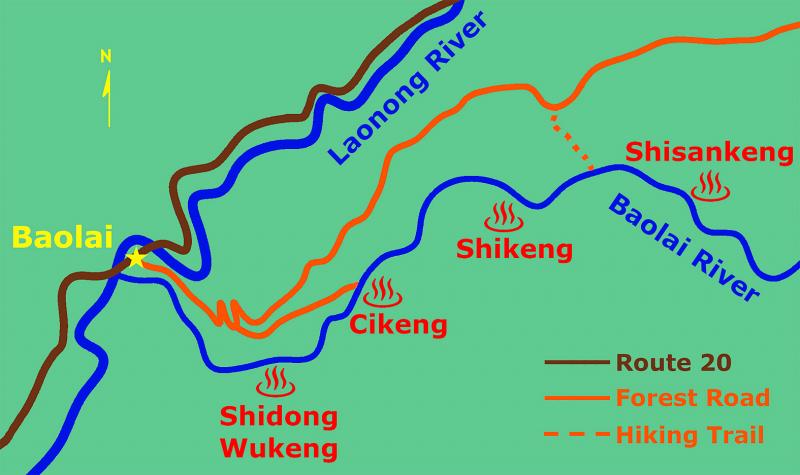
Map: Tyler Cottenie
Shisankeng is a classic wild hot spring: Tucked in a gorge below the towering peaks of the Central Mountain Range, it features a colorful wall (described in Chinese as a multi-tiered “cake”); multiple levels of large, fully natural pools with sandy bottoms; cold, clear river water access nearby; and of course, not a motor vehicle for miles around. There are open spaces nearby for those who wish to camp here, though it is recommended to arrive early as flat spots are limited. A night under the black skies here with nothing but the glint of starlight, the burbling of the hot spring and the occasional call of a barking deer for company truly captures the essence of Taiwan’s magnificent wilderness.
OTHER CONSIDERATIONS
Footing can be tricky while river tracing, so helmets and river tracing shoes are recommended. The path descending from the forest road is steep and slippery, so hiking shoes with good grip are necessary. Riverbed walking is very exposed, so sun protection and adequate drinking water are also essential. None of these hot springs should be visited in rainy weather, as the Baolai River can quickly turn into an unforgiving torrent. Finally, there is no cell phone service in the riverbed, so visitors may want to take a satellite communication device for emergencies.
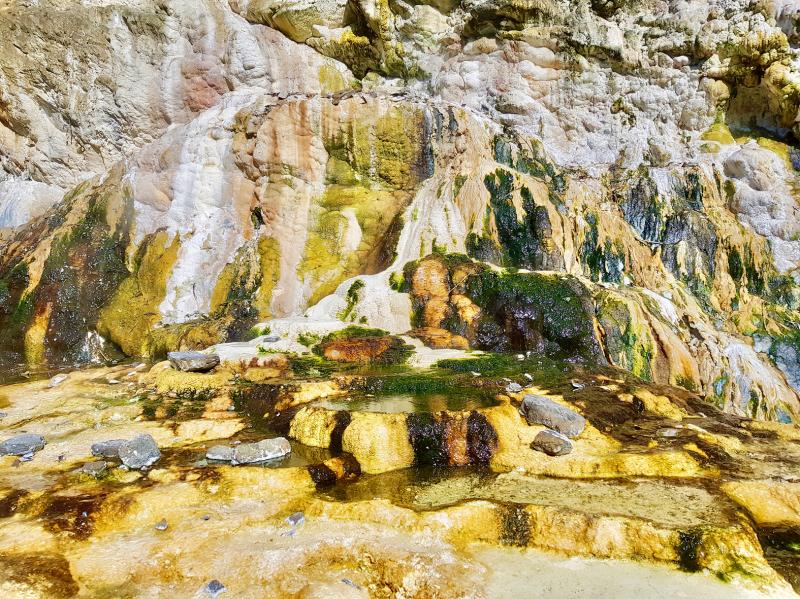
Photo: Tyler Cottenie
Though the policy is not enforced well, police permits are legally required for trips along the Siaoguanshan Forest Road. They can be easily obtained online (Chinese only) at least 3 days in advance (bit.ly/2KzshPp), or in person at the police station in Baolai.

Following the shock complete failure of all the recall votes against Chinese Nationalist Party (KMT) lawmakers on July 26, pan-blue supporters and the Chinese Communist Party (CCP) were giddy with victory. A notable exception was KMT Chairman Eric Chu (朱立倫), who knew better. At a press conference on July 29, he bowed deeply in gratitude to the voters and said the recalls were “not about which party won or lost, but were a great victory for the Taiwanese voters.” The entire recall process was a disaster for both the KMT and the Democratic Progressive Party (DPP). The only bright spot for

Water management is one of the most powerful forces shaping modern Taiwan’s landscapes and politics. Many of Taiwan’s township and county boundaries are defined by watersheds. The current course of the mighty Jhuoshuei River (濁水溪) was largely established by Japanese embankment building during the 1918-1923 period. Taoyuan is dotted with ponds constructed by settlers from China during the Qing period. Countless local civic actions have been driven by opposition to water projects. Last week something like 2,600mm of rain fell on southern Taiwan in seven days, peaking at over 2,800mm in Duona (多納) in Kaohsiung’s Maolin District (茂林), according to

Aug. 11 to Aug. 17 Those who never heard of architect Hsiu Tse-lan (修澤蘭) must have seen her work — on the reverse of the NT$100 bill is the Yangmingshan Zhongshan Hall (陽明山中山樓). Then-president Chiang Kai-shek (蔣介石) reportedly hand-picked her for the job and gave her just 13 months to complete it in time for the centennial of Republic of China founder Sun Yat-sen’s birth on Nov. 12, 1966. Another landmark project is Garden City (花園新城) in New Taipei City’s Sindian District (新店) — Taiwan’s first mountainside planned community, which Hsiu initiated in 1968. She was involved in every stage, from selecting

As last month dawned, the Democratic Progressive Party (DPP) was in a good position. The recall campaigns had strong momentum, polling showed many Chinese Nationalist Party (KMT) lawmakers at risk of recall and even the KMT was bracing for losing seats while facing a tsunami of voter fraud investigations. Polling pointed to some of the recalls being a lock for victory. Though in most districts the majority was against recalling their lawmaker, among voters “definitely” planning to vote, there were double-digit margins in favor of recall in at least five districts, with three districts near or above 20 percent in